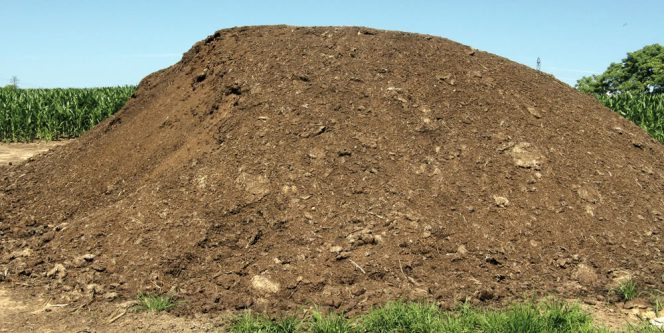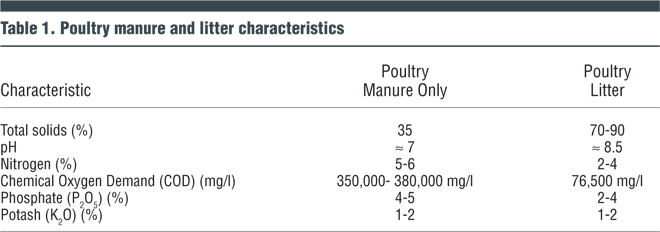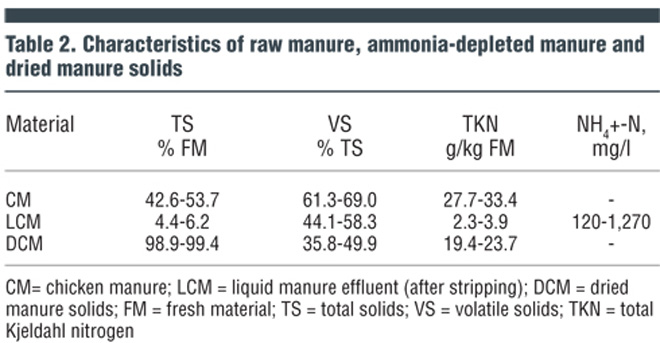Poultry litter — a heterogeneous and fairly dry mix that includes manure and bedding — can be diluted to improve its digestibility.
Part I
Craig Coker
BioCycle September 2017

Poultry litter contains valuable major and minor plant nutrients, and a significant amount of energy. Photo courtesy Gary Flory, Virginia DEQThe U.S. Department of Agriculture estimates 2016 U.S. poultry inventory at 8.77 billion broilers (raised for meat), 1.64 billion layers producing 101.9 billion eggs, and 244 million turkeys. This population of birds produces about 550 million tons of manure each year (by comparison, Americans produced about 254 million tons of solid waste in 2014). Most of this manure is directly land applied to cropland to take advantage of its high nutrient content. But in some poultry producing regions, over application of manure has led to high soil nutrient content, with runoff from those areas contributing to water quality and potential public health problems.
This reality has led to investigation of alternative methods to manage poultry manure and litter, including composting, anaerobic digestion (AD) and gasification. Of the 259 anaerobic digesters in the U.S. EPA AgSTAR’s database, only four use poultry manure and litter. Anaerobic digestion (AD) of poultry manure has several important benefits: creates a more stable product for use, removes nuisance odors, maintains the nutrient value of the litter, reduces attraction for vectors and produces a renewable fuel. However, digesting poultry litter can be very operationally challenging, which is one reason why more poultry-based AD systems are not in use today.
Poultry Litter Characteristics
Poultry litter (PL) is a heterogeneous mix of manure, urine, bedding, waste feed, feathers and mortalities. Its composition varies widely due to variations in bedding. Common bedding materials include sawdust, shavings, wheat straw, peanut hulls, and rice hulls.
These bedding materials are sometimes sold as feedstock to the biomass industry, increasing bedding costs to poultry farmers. This is causing a shift in PL management, away from “whole house” cleanouts — where farmers sweep everything out of a poultry house in between growing flocks — to newer management techniques of “decaking” or “crusting” between flocks (just skimming the manure off the surface of the bedding) and only doing a whole-house cleanout annually. While decaking saves money by reducing bedding expense, it makes PL feedstocks going into a processing system even more variable. The few AD plants handling poultry manure generally convert it to a slurry to equalize variations.
Poultry litter contains valuable major and minor plant nutrients, and a significant amount of energy. The dry basis heat content (Higher Heating Value, or HHV) of broiler litter is about 14,300 kilojoules per kilogram of dry matter (kJ/kgDM). The net heat content (Lower Heating Value, or LHV) of litter at 24 percent moisture is comparable to common solid fuels used for space heating and electric power generation (Chastain, 2012). Poultry litter compares favorably with wood chips and lignite (brown coal). The net heat value of wood chips with a moisture content of 35 percent is only 17 percent greater than poultry litter and the LHV of lignite is only 36 percent greater than litter.
Suitability For Digestion
Table 1 summarizes poultry manure and poultry litter characteristics. Factors that influence the efficiency of anaerobic digestion of PL (as with any substrate) include: feedstock properties, total suspended solids, volatile solids content, temperatures, pH, hydraulic residence time (the number of days feedstock stays in the digester), solids residence time (the ratio between the quantities of solids maintained in the digester vs. quantities removed daily), rate of digester loading, concentration of ammonia, digester type and whether other materials are codigested (Singh, 2010).
For example, anaerobic bacteria (“anaerobes”) have difficulty digesting lignins (a long-chain polymer molecule that gives woody material structural strength) or certain hydrocarbons (such as some waxes and lipids found in food wastes). PL comprised of a wood chip or sawdust bedding contains nondigestible lignins.
Solids concentrations also affect digestibility. As PL is a fairly dry material, in some cases it has been diluted with water (or the liquid fraction from digestate dewatering) to 5 to 6 percent solids. This has the added benefit of reducing possibly inhibitory concentrations of ammonia in the PL but digester reactor volume increases considerably. It takes 3,836 gallons of water to dilute one ton of PL from its initial moisture content of 24 percent to a liquefied moisture content of 94 percent. This yields about 3,600 gallons of dewatered digestate effluent that must be managed (Singh, 2010).
Concentrations of ammonia in the PL are very problematic to AD. Ammonia is formed by the anaerobic decomposition of uric acid and undigested proteins in the manure and in the wasted feed, producing high levels of unionized ammonia and ammonium ions. Concentrations of ammonia in excess of 250 mg/L have been found to inhibit biogas production; concentrations above 1,700 mg/L have caused digester failure in unacclimated digesters, although acclimating anaerobes to ammonia over a period of time raises their tolerance to about 5,000 mg/L (Yenigün, 2013). In one study, a poultry manure-hay bedding blend had a measured ammonia concentration of 7,000 mg/L (0.7%) (Rajagopal, 2016).
German researchers (Belostotskiy, 2013) evaluated removing ammonia to below inhibitory levels by using a sulfuric or phosphoric acid stripper. The stripping conditions were 80°C, 600 mbar absolute pressure for 4 hours during which ammonia was evaporated into the gas phase, withdrawn through condensation and trapped in sulfuric or phosphoric acid, yielding ammonia-sulfate or ammonia-phosphate fertilizer by-products. Before stripping, the effluent was separated into a solid and a liquid fraction through sieving. The liquid phase (LCM) underwent the stripping process, whereas the solids were dried (DCM). Recirculating the ammonia-depleted LCM into the fermenter lowered total ammonia concentration in the fermenter. Table 2 lists the characteristics of the raw and processed chicken manure.
Gas yield from the LCM was on the order of 6,000 to 9,000 cubic feet/ton. The test was run for 573 days, so while the technique worked, it is unlikely to be cost-effective.
The dry fermentation AD method also has been investigated as a way of digesting PL with less risk of ammonia-induced inhibition. While dry fermentation avoids the larger digester reactors needed with liquefied PL, the hydraulic retention time (HRT) has to be longer, the process needs a large amount of inoculum (a bacterial starter mix) to start the AD process quickly, and start-up performance can be challenging due to incomplete mixing of PL and inoculum and to the accumulation of volatile fatty acids in the pile (Rajagopal, 2016).
Part II of this article covers gas yield and quality, digestate management and case studies.
Craig Coker is a Senior Editor at BioCycle and CEO of Coker Organics Recycling (www.cokercompost.com) near Roanoke, VA. He can be reached at ccoker@jgpress.com.












